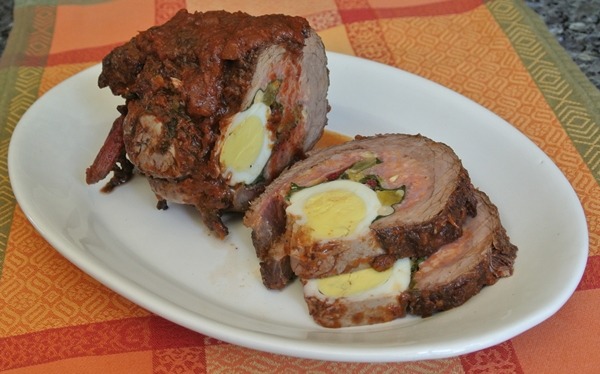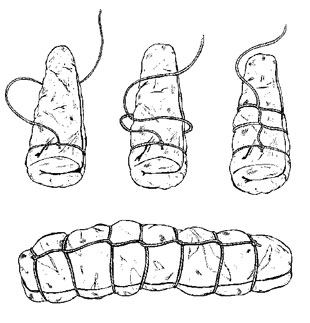 I read a lot of articles about how falso magro got its name. The name translates roughly to “falsely lean” or “falsely Lenten”. There are stories about how it started as a humble dish and some French chef got a hold of it and gussied it up.
I read a lot of articles about how falso magro got its name. The name translates roughly to “falsely lean” or “falsely Lenten”. There are stories about how it started as a humble dish and some French chef got a hold of it and gussied it up.
I tend to think this is another example of Italians thumbing their nose at the Church – like strozzapretti, or The Pope’s Nose. In the case of falso magro, what looks like a humble meat roast is in fact a gluttonous and opulent dish, filled with other meats, cheese, pine nuts, raisins, and hard boiled eggs that resemble coins when sliced. Hence the name, “falsely lean” (it’s not lean at all) or “falsely Lenten” (it dodges the Lenten practice of restraint).
Substitutions are the fun part of this dish. Use what you like, as long as the surprise when slicing it is preserved. You can also use veal or pork for the meat. The tomato sauce and hard boiled eggs can be made in advance. The whole roast can also be assembled a day before and refrigerated until ready to brown and braise. Serve with a green vegetable, such as sauteed broccoli or kale.
This recipe makes 4-6 main course servings.
Ingredients and Directions:
- 1 ½ pound flank steak – pounded thin
- 2 links Italian sausage – casings removed and sausage broken up
- 4-6 slices of Mortadella or other salumi
- 2 big Swiss Chard leaves – blanched in boiling water for 5 minutes, drain and pat dry on a paper towel
- 1/2 cup grated Caciocavallo cheese or other provolone cheese
- 3 or 4 hard boiled eggs
- Toasted pine nuts (see Note)
- Re-hydrated raisins (see Note)
- Tomato sauce
- 1/2 bottle red wine
- Salt and pepper
Special Equipment:
- A meat-pounding mallet
- Kitchen twine
- A large cast iron pot
Note: To toast pine nuts, place them in a dry saute pan over medium-high heat and swirl around frequently until toasted to a light brown. Remove immediately to another bowl. To rehydrate raisins, place in a bowl and pour over hot water. Let sit for 10 minutes and drain.
- Lay the pounded flank steak out on a cutting board. Season liberally with salt and pepper.
- Layer on the stuffing ingredients, roughly in this order —
- Crumbled sausage – pressed flat with your hands
- Sliced Mortadella – slices slightly overlapped
- Swiss Chard leaves
- Caciocavallo cheese – sprinkled over the entire surface
- Hard boiled eggs – lined up in a row down the center
- Toasted pine nuts and raisins – sprinkled over the entire surface
- Now this is where another person will help – roll-up the roast like a jellyroll and tie with kitchen twine as shown in the diagram

How to tie a roast - Heat oven to 350° degrees.
- Place the large cast iron pot over medium-high heat. Add a thin layer of extra virgin olive oil. Heat until the oil is shimmering. Add the roast and brown on all sides.
- Remove the roast to a board. Add the red wine to de-glaze the pot. Boil the wine until reduced by half. Add the tomato sauce and mix with the wine. Bring the mixture back to a simmer.
- Place the roast back in the pot and coat with the sauce. Cover with a lid and braise in the heated oven for 1 hour. During the cooking, rotate the roast several times, each time coating with the sauce.
- Remove from the oven. Remove the roast from the pot and place on a clean cutting board. Let it rest for 15 minutes. If the sauce is too thin, place the pot back on the stove on medium heat, and reduce the sauce till thick. Remember the pot is HOT at this point!
- Remove the kitchen twine. Thickly slice and serve with some of the sauce.

What is the Sicilian name given to Farso Magro?It is well known in Buffalo but I don’t remember what it is called?????????
Oh gosh, I don’t know of a Sicilian name! I’m from a Sicilian family too and we always called it Falsomagro…